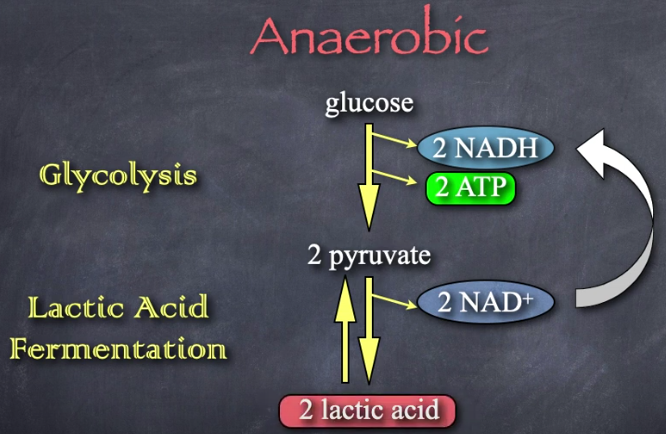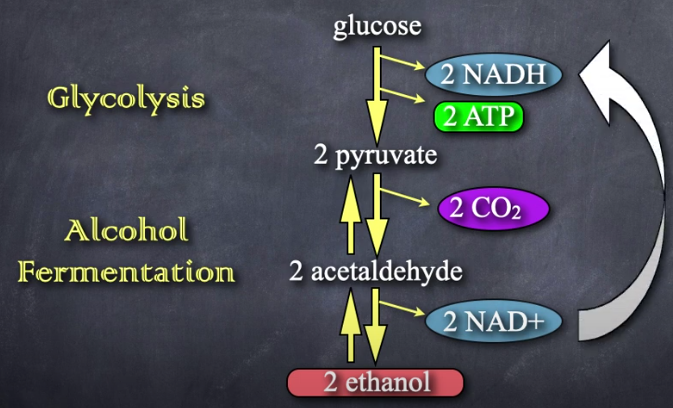IB BIO - U2L16P2 - Anaerobic Respiration + Respective Theoretical Yield.
1/5
There's no tags or description
Looks like no tags are added yet.
Name | Mastery | Learn | Test | Matching | Spaced |
|---|
No study sessions yet.
6 Terms
Stage 1 of Aerobic Respiration.
Glycolysis.
Glucose →Pyruvate
Produces:
2 NADH
2 ATP
Stage 2a of Anaeerobic Respiration.
Lactic Acid Fermentation.
(2) Pyruvate →(2) Lactic Acid
Produces:
2 NAD+
NAD+ is to be replenished to propagate the cycle via glycolysis.
In animals, this occurs via a reversible process dubbed lactic acid fermentation.
If oxygen is available this process goes into pyruvate oxidation.
2 ATP/Glucose molecule is produced.
Lactic acid (lactate) is a toxic byproduct.

Lactic Acid and Exercise
During intense exercise, cell energy demands exceed what oxygen gas can readily supply aerobically.
After exercise, oxygen levels will increase and lactate will be converted back to pyruvate.
Body maximises ATP yield by anaerobic respiration of glucose too.
Only Carbohydrates typically undergo anaerobic respiration.
Stage 2b of Aerobic Respiration.
Alcohol Fermentation.
(2) Pyruvate →(2) CO2
Produces:
2 NAD+
NAD+ is to be replenished to propagate the cycle via glycolysis.
In plants and yeast, this occurs via a reversible process dubbed alcohol fermentation.
The conversion of pyruvate to lactic acid involves the transfer of electrons from NADH to pyruvate.
This electron transfer regenerates NAD+ from NADH.
If oxygen is available this process goes into pyruvate oxidation.
2 ATP/Glucose molecule is produced.
Lactic acid (lactate) is a toxic byproduct.

Anaerobic vs. Aerobic Respiration.
Reactants.
Anaerobic
Glucose.
Aerobic
Glucose.
Oxygen.
Combustion.
Anaerobic.
Incomplete.
Aerobic
Combustion.
Energy Yield.
Anaerobic.
Low (2 ATP)
Aerobic
High (36 - 38 ATP)
Products.
Anaerobic
Animals: Lactic Acid.
Yeast + Plants: Ethanol + CO2
Aerobic
CO2 and H2O
Location.
Anaerobic.
Cytoplasm.
Aerobic.
Cytoplasm.
Mitochondrion.
Stages.
Anaerobic.
Glycolysis.
Fermentation.
Aerobic
Glycolysis
Link Reaction
Krebs Cycle
Electron Transport Chain
Types of Aerobic Reactions.
Decarboxylation.
Decarboxylation involves the removal of a carbon dioxide (CO2) molecule from a compound. In the context of aerobic reactions, decarboxylation often occurs in the citric acid cycle (Krebs cycle) during cellular respiration.
During the Krebs cycle, decarboxylation reactions lead to the release of CO2, contributing to the overall breakdown of glucose and the generation of energy.
Oxidation.
Oxidation is a chemical process that involves the loss of electrons or an increase in oxidation state. In cellular respiration, oxidation reactions are central to the transfer of electrons from energy-rich molecules (like glucose) to electron carriers (such as NAD+ and FAD), ultimately leading to the production of ATP.
The ETC, which is a key part of aerobic respiration, involves a series of oxidation-reduction reactions.
Phosphorylation.
Phosphorylation involves the addition of a phosphate group to a molecule. In cellular respiration, phosphorylation is a key step in the generation of ATP.
Oxidative phosphorylation:
Occurs in the ETC, where the flow of electrons through protein complexes is coupled to the phosphorylation of ADP to ATP.
